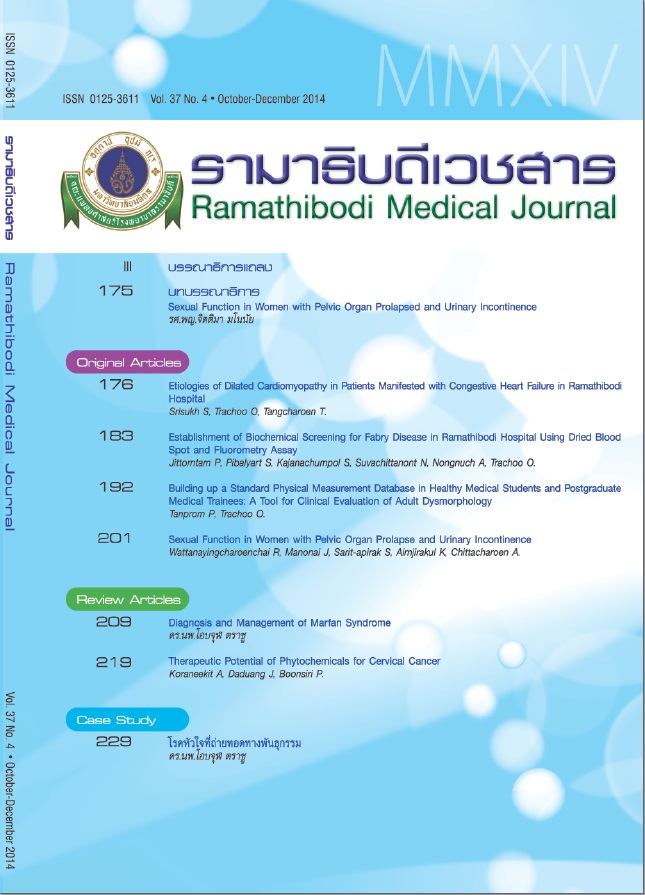Etiologies of Dilated Cardiomyopathy in Patients Manifested With Congestive Heart Failure in Ramathibodi Hospital
Keywords:
Congestive heart failure, CardiomyopathyAbstract
Background: Dilated cardiomyopathy (DCM) has a prevalence of 36.5 cases per 100,000 persons in USA. It represents a major health burden and also remains the primary indication for heart transplantation. Almost half to the cases are idiopathic and 20 - 50% of these patients are found to have monogenic associations. Familial DCM is usually asymptomatic and the patients are frequently present at the late stage. In Thailand, no certain prevalence of Familial DCM has been studied. Hence, this work is expected to provide the further benefit of genetic study in this particular condition.
Methods: During January 2011 – December 2012, the data of all clinical cases presented with heart failure and underwent coronary angiography were recruited. Only the patients with normal coronary angiography were included. Family history, comorbidity diseases, current and previous medications, body mass index, laboratory data including kidney function, thyroid function test, and echocardiography report were collected. The etiologies of DCM were characterized into hereditary and known acquired causes. The diagnoses of idiopathic and familial DCM were performed relying on the clinical practice guideline.
Results: Total 178 patients presented with heart failure were recruited for the study and 72 (40.45%) met the criteria for either definite or suspected DCM (39 and 33 patients, repectively). Diabetes mellitus, arrhythmias and chronic kidney diseases were the most common etiologies of impaired systolic function without significant coronary artery disease whereas hyperthyroidism and morbid obesity occurred less frequently. Twelve from 72 patients were defined as unknown acquired etiologies (idiopathic DCM). Among these 12 patients, only 1 patient had history of familial dilated cardiomyopathy (8.33%). However, these patients from 12 patients (25%) were characterized as having positive family histories, but the clinical data in their affected family member did not meet the complete criteria for DCM.
Conclusions: Approximately 17% of our patients affected by DCM are classified as idiopathic. This finding suggests the possibility to have underlying monogenic mechanism. Hence, this is a pilot study for further gene and mutation study in idiopathic and familial DCM in Thai population.
References
Richardson P, McKenna W, Bristow M, et al. Report of the 1995 World Health Organization/International Society and Federation of Cardiology Task Force on the Definition and Classification of cardiomyopathies. Circulation. 1996;93(5):841-842.
Codd MB, Sugrue DD, Gersh BJ, Melton LJ 3rd. Epidemiology of idiopathic dilated and hypertrophic cardiomyopathy. A population-based study in Olmsted County, Minnesota, 1975-1984. Circulation. 1989;80(3):564-572.
Manolio TA, Baughman KL, Rodeheffer R, et al. Prevalence and etiology of idiopathic dilated cardiomyopathy (summary of a National Heart, Lung, and Blood Institute workshop. Am J Cardiol. 1992;69(17):1458-1466.
van Spaendonck-Zwarts KY, van Rijsingen IA, van den Berg MP, et al. Genetic analysis in 418 index patients with idiopathic dilated cardiomyopathy: overview of 10 years' experience. Eur J Heart Fail. 2013;15(6):628-636. doi:10.1093/eurjhf/hft013.
Michels VV, Moll PP, Miller FA, et al. The frequency of familial dilated cardiomyopathy in a series of patients with idiopathic dilated cardiomyopathy. N Engl J Med. 1992;326(2):77-82.
Hershberger RE1, Cowan J, Morales A, Siegfried JD. Progress with genetic cardiomyopathies: screening, counseling, and testing in dilated, hypertrophic, and arrhythmogenic right ventricular dysplasia/cardiomyopathy. Circ Heart Fail. 2009;2(3):253-261. doi:10.1161/CIRCHEARTFAILURE.108.817346.
Hershberger RE, Lindenfeld J, Mestroni L, et al. Genetic evaluation of cardiomyopathy--a Heart Failure Society of America practice guideline. J Card Fail. 2009;15(2):83-97. doi:10.1016/j.cardfail.2009.01.006.
Hunt SA, Abraham WT, Chin MH, et al. 2009 focused update incorporated into the ACC/AHA 2005 Guidelines for the Diagnosis and Management of Heart Failure in Adults: a report of the American College of Cardiology Foundation/American Heart Association Task Force on Practice Guidelines: developed in collaboration with the International Society for Heart and Lung Transplantation. Circulation. 2009;119(14):e391-479. doi:10.1161/CIRCULATIONAHA.109.192065.
Mestroni L, Maisch B, McKenna WJ, et al. Guidelines for the study of familial dilated cardiomyopathies. Collaborative Research Group of the European Human and Capital Mobility Project on Familial Dilated Cardiomyopathy. Eur Heart J. 1999;20(2):93-102.
Hershberger RE, Siegfried JD. Update 2011: clinical and genetic issues in familial dilated cardiomyopathy. J Am Coll Cardiol. 2011;57(16):1641-1649. doi:10.1016/j.jacc.2011.01.015.
Mohan SB, Parker M, Wehbi M, Douglass P. Idiopathic dilated cardiomyopathy: a common but mystifying cause of heart failure. Cleve Clin J Med. 2002;69(6):481-487.
Kasper EK, Agema WR, Hutchins GM, Deckers JW, Hare JM, Baughman KL. The causes of dilated cardiomyopathy: a clinicopathologic review of 673 consecutive patients. J Am Coll Cardiol. 1994;23(3):586-590.
Dec GW, Fuster V. Idiopathic dilated cardiomyopathy. N Engl J Med. 1994;331(23):1564-1575.
Coughlin SS, Tefft MC. The epidemiology of idiopathic dilated cardiomyopathy in women: the Washington DC Dilated Cardiomyopathy Study. Epidemiology. 1994;5(4):449-455.
Coughlin SS, Pearle DL, Baughman KL, Wasserman A, Tefft MC. Diabetes mellitus and risk of idiopathic dilated cardiomyopathy. The Washington, DC Dilated Cardiomyopathy Study. Ann Epidemiol. 1994;4(1):67-74.
Mason JW. Myocarditis and dilated cardiomyopathy: an inflammatory link. Cardiovasc Res. 2003;60(1):5-10.













